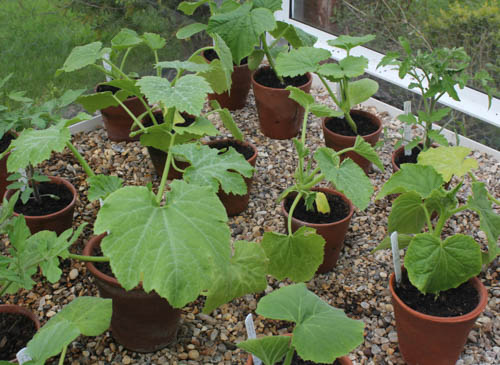
After a wet, cold May and low light, let’s hope plants and people can finally enjoy some sunshine.
Aubergines, peppers and chillies should be transplanted into pots one or two sizes larger once they have formed a good root system but before they become pot bound. Transplant repeatedly until they reach a final pot size of 23 cm pots or enough to fit two per growing bag. Pinch out the tips from the main stems of aubergines when they are 30-40cm tall. Stake or tie into supports as necessary.
Aubergines are ‘buzz pollinated’ and wait until the wings of the bee reach the correct frequency before releasing the pollen, like tomatoes, they can be pollinated by tapping the flowers, ideally when the pollen is dry on a bright sunny day. Only allow five or six evenly spaced fruit per plant and remove further flowers.
Keep your crops well-watered with tepid water, use tap water for seedlings to avoid water borne problems from the water butt. Pay particular attention to crops in growing bags, the relatively small plant:compost ratio means they can dry out rapidly in hot weather. Erratic watering causes calcium deficiency and ‘blossom end rot’ when the end of the fruit furthest away from the stem turns black. They are still edible if you slice off the blackened end.
Feed plants in pots regularly to encourage healthy growth and fruiting.
Keep pots weed free, using a pair of tweezers to remove weeds at the seedling stage. Repeatedly pull the foliage from Oxalis corniculata, the ‘Purple Leaved Oxalis’ to weaken the plant. Don’t let it flower and set seed, it is a pernicious weed.
Check plants daily pests like whitefly and red spider mite as small infestations are easier to control and use environmentally friendly sprays like Plant Invigorator or biological controls. Check the undersides of leaves for whitefly.
Remove the side shoots of ‘cordon’ varieties to form a single productive stem. They snap off easily using your finger and thumb. Make sure your tomatoes are well watered, too, particularly if they are in growing bags where the compost dries out rapidly. You may need to water them twice a day.
In cooler climates or other locations for rapid germination, it is still not too late to sow sweetcorn. Use deep pots or recycled drinking cups with a drainage hole in the base, then ‘harden off’ and transplant under fleece until acclimatised; sow French and runner beans in root trainers and pumpkins on edge in individual pots.
Ventilate the greenhouse on hot days before internal temperatures rise and shading with greenhouse paint or internal blinds to avoid scorching. Damp down the floor of the greenhouse regularly on hot days to increase humidity, encourage plant growth and reduce the risk of pest problems such as glasshouse red spider mite.
Move citrus plants outdoors if you haven’t already done so. Put them in a sheltered, sunny spot. If night temperatures are low, wrap them in fleece for 10-14 days at night to allow them to acclimatise. Remove the top 2” of compost and top dress with a new layer of fresh citrus compost. Happy Gardening. Matt










